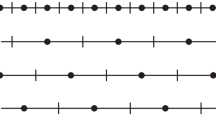Abstract
A modified version of the previously reported ghost-cell immersed boundary method is implemented in parallel environment based on distributed memory allocation. Reconstruction of the flow variables is carried out by the inverse distance weighting technique. Implementation of the normal pressure gradient on the immersed surface is demonstrated. Finite volume method with non-staggered arrangement of variables on a non-uniform cartesian grid is employed to solve the fluid flow equations. The proposed method shows reasonable agreement with the reported results for flow past a stationary sphere, rotating and transversely oscillating circular cylinder.












Similar content being viewed by others
References
Peskin C S 1972 Flow patterns around heart valves:a numerical method. J. Comput. Phys. 10: 252–271
Goldstein D, Handler R and Sirovich L 1993 Modelling a no-slip flow boundary with an external force field. J. Comput. Phys. 105: 354–366
Mohd-Yosuf J 1997 Combined immersed-boundary/ b-spline methods for simulations of flow in complex geometries. CTR, Annual Research Briefs 317–327
Kim J, Kim D and Choi H 2001 An immersed-boundary finite-volume method for simulations of flow in complex geometries. J. Comput. Phys. 171: 132–150
Majumdar S, Iaccarino G and Durbin P 2001 Rans solvers with adaptive structured boundary non-conforming grids. CTR, Annual Research Briefs 353–366
Tseng Y H and Ferziger J H 2003 A ghost-cell immersed boundary method for flow in complex geometry. J. Comput. Phys. 192: 593–623
Mittal R, Dong H, Bozkurttas M, Najjar F M, Vargas A and Loebbecke A V 2008 A versatile sharp interface immersed boundary method for incompressible flows with complex boundaries. J. Comput. Phys. 227: 4825–4852
De A K 2014 An implicit non-staggered cartesian grid method for incompressible viscous flows in complex geometries. Sadhana Ind. Acad. Sci. 39: 1071–1094
Lee J and You D 2013 An implicit ghost-cell immersed boundary method for simulations of moving body problems with control of spurious force oscillations. J. Comput. Phys. 233: 295–314
Kim D and Choi H 2006 Immersed boundary method for flow around an arbitrarily moving body. J. Comput. Phys. 212: 662–680
Iaccarino G and Verzicco R 2003 Immersed boundary technique for turbulent flow simulations. Appl. Mech. Rev. 56: 331–347
Gao T, Tseng Y H and Lu X Y 2007 An improved hybrid cartesian/immersed boundary method for fluid-solid flows. Int. J. Numer. Meth. Fluids 55: 1189–1211
Mittal R and Iaccarino G 2005 Immersed boundary methods. Annu. Rev. Fluid Mech. 37: 239–261
Pope S B 2000 Turbulent lows. Cambridge University Press. Cambridge
De A K and Dalal A 2006 Numerical simulation of unconfined flow past a triangular cylinder. Int. J. Numer. Meth. Fluids 52: 801–821
Stone H L 1968 Iterative solution of implicit approximation of multidimensional partial differential equations. SIAM J. Numer. Anal. 5: 530–558
Zhang S-L 1997 Gpbi-cg:Generalized product-type methods based on bi-cg for solving nonsymmetric linear systems. SIAM J. Sci. Comput. 18(2): 537–551
Hunt J C R, Wray A A and Moin P 1988 Eddies, streams, and convergence zones in turbulent flows. Center for Turbulence Research Report CTR-S88 2, 193–208
Johnson T A and Patel V C 1999 Flow past a sphere up to a Reynolds number of 300. J. Fluid Mech. 378: 19–70
Den Hartog J P 1934 The vibration problems in engineering. In: Proceedings of the 4th International Congresson Applied Mechanics Cambridge, U K, pp. 36–53
Bishop R E D and Hassan A Y 1964 The lift and drag forces on a circular cylinder oscillating in a flowing fluid. Proc. R. Soc. Lond. Ser. A 277: 51–75
Koopmann G H 1967 The vortex wakes of vibrating cylinders at low reynolds number. J. Fluid Mech. 23: 501–512
Zdravkovich M M 1982 Modification of vortex shedding in the synchronization range. ASME J. Fluids Eng. 104: 513–517
Williamson C H K and Roshko A 1988 Vortex formation in the wake of an oscillating cylinder. J. Fluids Struct. 2: 355–381
Guilmineau E and Queutey P 2002 A numerical simulation of vortex shedding from an oscillating circular cylinder. J. Fluids Struct. 16: 773–794
Zhou C H and Shu C 2011 A local domain-free discretization method for simulation of incompressible flows over moving bodies. Int. J. Numer. Meth. Fluids 66: 162–182
Kang S, Choi H and Lee S 1999 Laminar flow past a rotating circular cylinder. Phys. Fluids 11: 3312–3321
Stojkovic D, Breuer M and Durst F 2002 Effect of high rotation rates on the laminar flow around a circular cylinder. Phys. Fluids 14: 3160–3178
Mittal S and Kumar B 2003 Flow past a rotating cylinder. J. Fluid Mech. 476: 303–334
Kumar S, Cantu C and Gonzalez B 2011 Flow past a rotating cylinder at low and high rotation rates. ASME J. Fluid Eng. 133: 041201–1–041201–9
Acknowledgments
The present research was carried out on the funds available through the institute start-up Grant SG/ME/P/ARKD/1/2009-2010 and DST First Track Grant SERC/ET-0166/2011.
Author information
Authors and Affiliations
Corresponding author
Appendix
Appendix
Finite difference approximations of the partial derivatives in non-uniform grids at a point (\(x_i,y_j,z_k\))
First derivatives
Second derivatives
Mixed derivatives
where
\(\Delta x_{i+1}=x_{i+1}-x_i\, , \,\,\,\Delta x_{i-1}=x_i-x_{i-1}\, , \,\,\,\Delta y_{j+1}=y_{j+1}-y_j\)
\(\Delta y_{j-1}=y_j-y_{j-1}\, ,\,\,\,\Delta z_{k+1}=z_{k+1}-z_k\, ,\,\,\,\Delta z_{k-1}=z_k-z_{k-1}\).
Rights and permissions
About this article
Cite this article
Peter, S., De, A.K. A parallel implementation of the ghost-cell immersed boundary method with application to stationary and moving boundary problems. Sādhanā 41, 441–450 (2016). https://doi.org/10.1007/s12046-016-0484-9
Received:
Revised:
Accepted:
Published:
Issue Date:
DOI: https://doi.org/10.1007/s12046-016-0484-9




